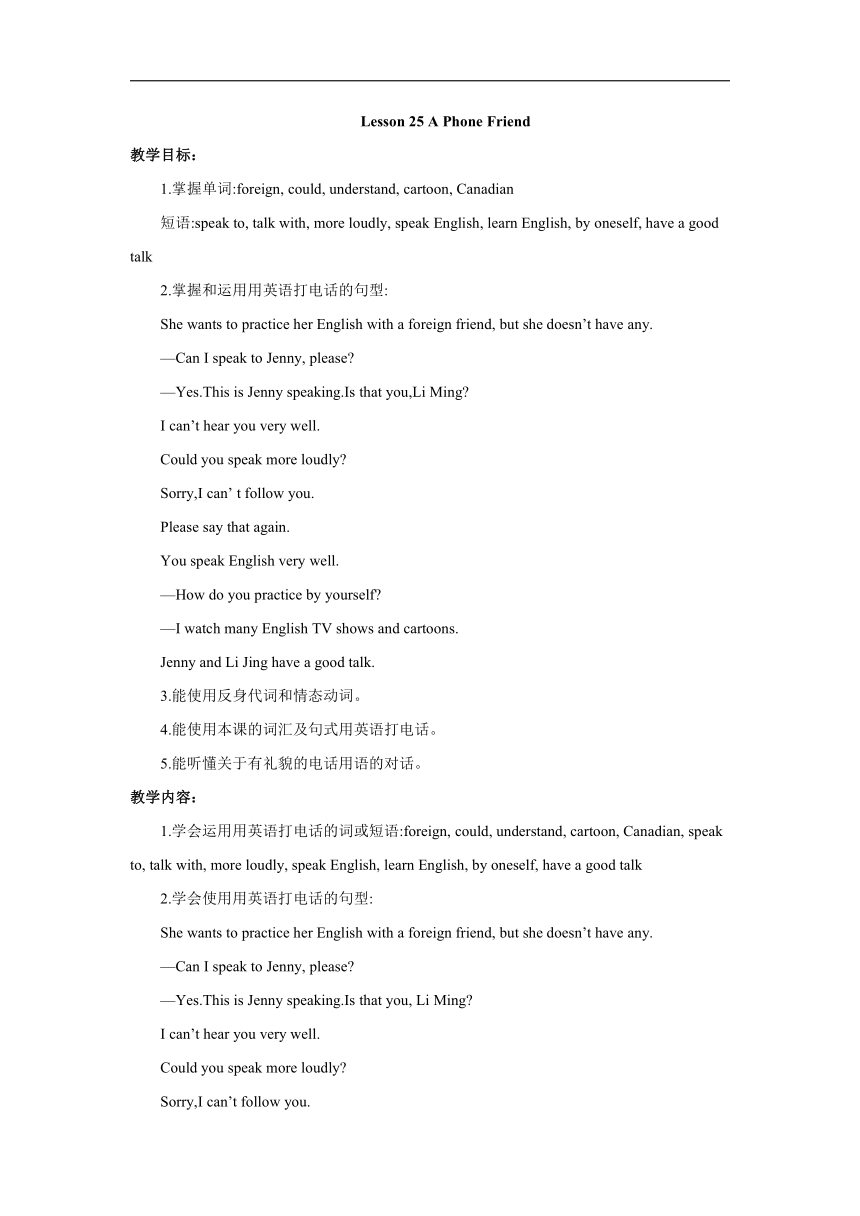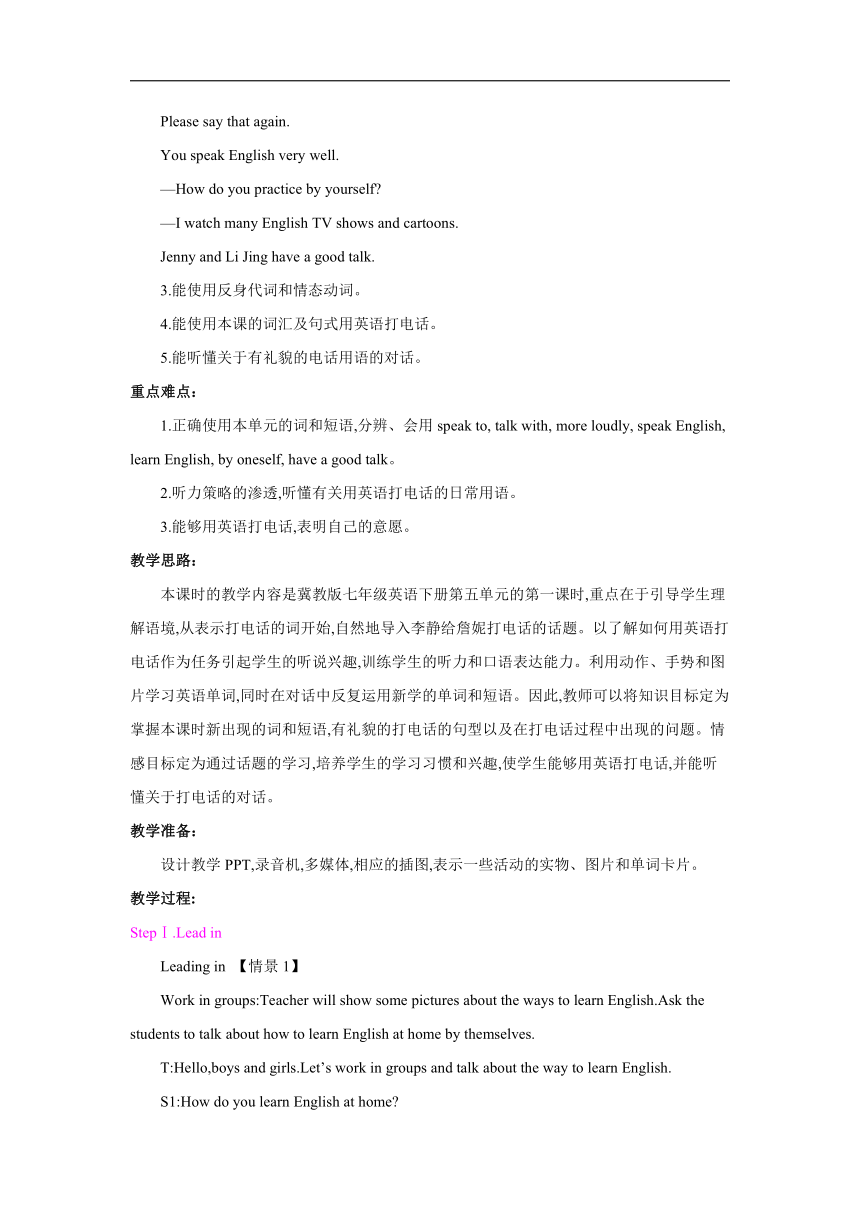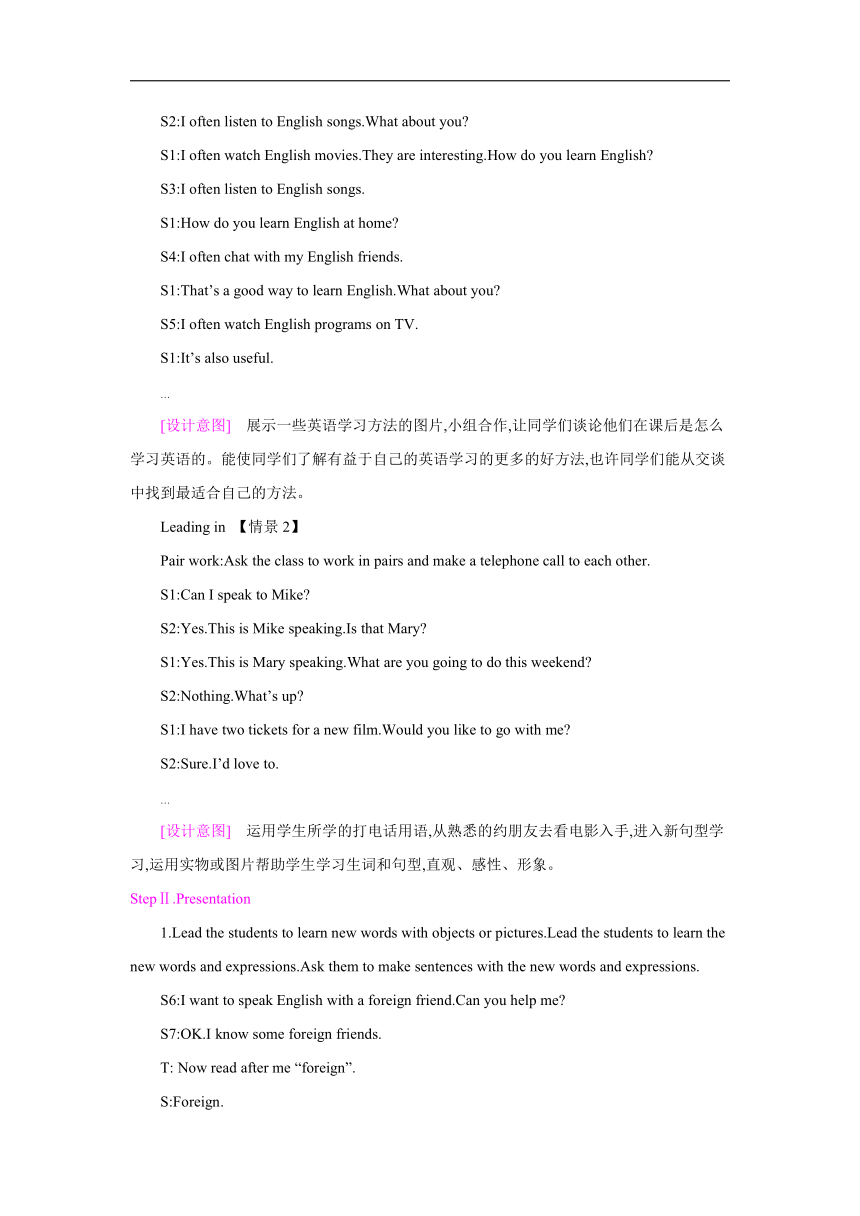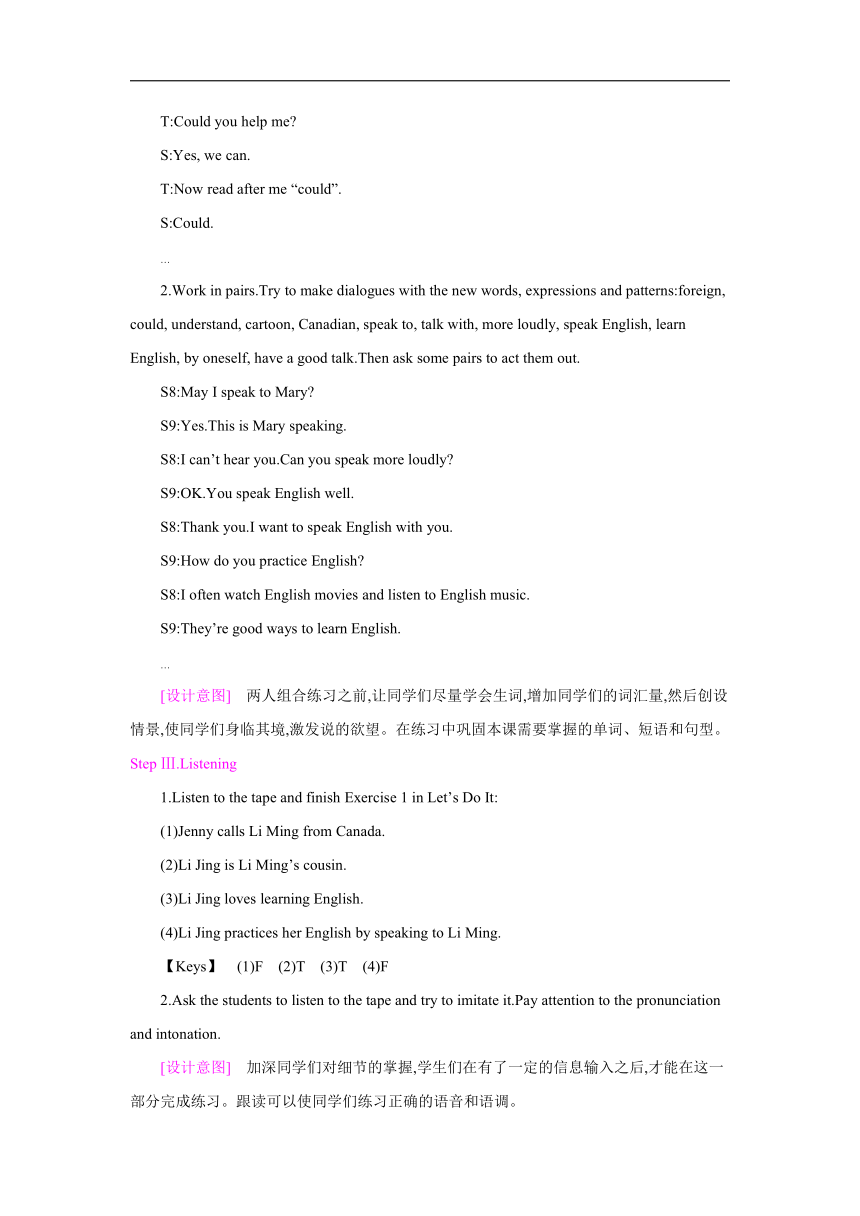Unit 5 I Love Learning English! Lesson 25 A Phone Friend 教学设计
文档属性
| 名称 | Unit 5 I Love Learning English! Lesson 25 A Phone Friend 教学设计 |  | |
| 格式 | zip | ||
| 文件大小 | 30.8KB | ||
| 资源类型 | 教案 | ||
| 版本资源 | 冀教版 | ||
| 科目 | 英语 | ||
| 更新时间 | 2019-06-27 16:39:39 | ||
图片预览




文档简介
Lesson 25 A Phone Friend
教学目标:
1.掌握单词:foreign, could, understand, cartoon, Canadian
短语:speak to, talk with, more loudly, speak English, learn English, by oneself, have a good talk
2.掌握和运用用英语打电话的句型:
She wants to practice her English with a foreign friend, but she doesn’t have any.
—Can I speak to Jenny, please?
—Yes.This is Jenny speaking.Is that you,Li Ming?
I can’t hear you very well.
Could you speak more loudly?
Sorry,I can’ t follow you.
Please say that again.
You speak English very well.
—How do you practice by yourself?
—I watch many English TV shows and cartoons.
Jenny and Li Jing have a good talk.
3.能使用反身代词和情态动词。
4.能使用本课的词汇及句式用英语打电话。
5.能听懂关于有礼貌的电话用语的对话。
教学内容:
1.学会运用用英语打电话的词或短语:foreign, could, understand, cartoon, Canadian, speak to, talk with, more loudly, speak English, learn English, by oneself, have a good talk
2.学会使用用英语打电话的句型:
She wants to practice her English with a foreign friend, but she doesn’t have any.
—Can I speak to Jenny, please?
—Yes.This is Jenny speaking.Is that you, Li Ming?
I can’t hear you very well.
Could you speak more loudly?
Sorry,I can’t follow you.
Please say that again.
You speak English very well.
—How do you practice by yourself?
—I watch many English TV shows and cartoons.
Jenny and Li Jing have a good talk.
3.能使用反身代词和情态动词。
4.能使用本课的词汇及句式用英语打电话。
5.能听懂关于有礼貌的电话用语的对话。
重点难点:
1.正确使用本单元的词和短语,分辨、会用speak to, talk with, more loudly, speak English, learn English, by oneself, have a good talk。
2.听力策略的渗透,听懂有关用英语打电话的日常用语。
3.能够用英语打电话,表明自己的意愿。
教学思路:
本课时的教学内容是冀教版七年级英语下册第五单元的第一课时,重点在于引导学生理解语境,从表示打电话的词开始,自然地导入李静给詹妮打电话的话题。以了解如何用英语打电话作为任务引起学生的听说兴趣,训练学生的听力和口语表达能力。利用动作、手势和图片学习英语单词,同时在对话中反复运用新学的单词和短语。因此,教师可以将知识目标定为掌握本课时新出现的词和短语,有礼貌的打电话的句型以及在打电话过程中出现的问题。情感目标定为通过话题的学习,培养学生的学习习惯和兴趣,使学生能够用英语打电话,并能听懂关于打电话的对话。
教学准备:
设计教学PPT,录音机,多媒体,相应的插图,表示一些活动的实物、图片和单词卡片。
教学过程:
StepⅠ.Lead in
Leading in 【情景1】
Work in groups:Teacher will show some pictures about the ways to learn English.Ask the students to talk about how to learn English at home by themselves.
T:Hello,boys and girls.Let’s work in groups and talk about the way to learn English.
S1:How do you learn English at home?
S2:I often listen to English songs.What about you?
S1:I often watch English movies.They are interesting.How do you learn English?
S3:I often listen to English songs.
S1:How do you learn English at home?
S4:I often chat with my English friends.
S1:That’s a good way to learn English.What about you?
S5:I often watch English programs on TV.
S1:It’s also useful.
…
[设计意图] 展示一些英语学习方法的图片,小组合作,让同学们谈论他们在课后是怎么学习英语的。能使同学们了解有益于自己的英语学习的更多的好方法,也许同学们能从交谈中找到最适合自己的方法。
Leading in 【情景2】
Pair work:Ask the class to work in pairs and make a telephone call to each other.
S1:Can I speak to Mike?
S2:Yes.This is Mike speaking.Is that Mary?
S1:Yes.This is Mary speaking.What are you going to do this weekend?
S2:Nothing.What’s up?
S1:I have two tickets for a new film.Would you like to go with me?
S2:Sure.I’d love to.
…
[设计意图] 运用学生所学的打电话用语,从熟悉的约朋友去看电影入手,进入新句型学习,运用实物或图片帮助学生学习生词和句型,直观、感性、形象。
StepⅡ.Presentation
1.Lead the students to learn new words with objects or pictures.Lead the students to learn the new words and expressions.Ask them to make sentences with the new words and expressions.
S6:I want to speak English with a foreign friend.Can you help me?
S7:OK.I know some foreign friends.
T: Now read after me “foreign”.
S:Foreign.
T:Could you help me?
S:Yes, we can.
T:Now read after me “could”.
S:Could.
…
2.Work in pairs.Try to make dialogues with the new words, expressions and patterns:foreign, could, understand, cartoon, Canadian, speak to, talk with, more loudly, speak English, learn English, by oneself, have a good talk.Then ask some pairs to act them out.
S8:May I speak to Mary?
S9:Yes.This is Mary speaking.
S8:I can’t hear you.Can you speak more loudly?
S9:OK.You speak English well.
S8:Thank you.I want to speak English with you.
S9:How do you practice English?
S8:I often watch English movies and listen to English music.
S9:They’re good ways to learn English.
…
[设计意图] 两人组合练习之前,让同学们尽量学会生词,增加同学们的词汇量,然后创设情景,使同学们身临其境,激发说的欲望。在练习中巩固本课需要掌握的单词、短语和句型。
Step Ⅲ.Listening
1.Listen to the tape and finish Exercise 1 in Let’s Do It:
(1)Jenny calls Li Ming from Canada.
(2)Li Jing is Li Ming’s cousin.
(3)Li Jing loves learning English.
(4)Li Jing practices her English by speaking to Li Ming.
【Keys】 (1)F (2)T (3)T (4)F
2.Ask the students to listen to the tape and try to imitate it.Pay attention to the pronunciation and intonation.
[设计意图] 加深同学们对细节的掌握,学生们在有了一定的信息输入之后,才能在这一部分完成练习。跟读可以使同学们练习正确的语音和语调。
Step Ⅳ.Reading
After listening to the conversations, get the class to read them aloud.Finish Exercise 2 in Let’s Do It.
1.Read the lesson and fill in the blanks.The first letter is given.
I love learning English.I p English every day by myself.But today I t to a foreign friend.Her name is Jenny.She is Li Ming’s friend.At first, we couldn’t u each other very well.Jenny asked me to s more loudly.And I couldn’t f her.But later, we h a good talk.I have a Canadian friend now.I feel so happy.?
【Keys】 practice,talked,understand,speak,follow,had
2.Group work:Read the text first, then ask at least 3 questions.After a while, you can ask anyone in your class to answer your questions.
Group 1:
S10:Who does Li Jing want to practice her English with?
S11:Does Li Jing speak English well?
S12:How does Li Jing practice English?
…
【Keys】 S10:A foreign friend.
S11:Yes, she does.
S12:She watches many English TV shows and cartoons and listens to English music.
…
3.Read and find the key points.
The following language points should be explained.
☆教材解读☆
1.So Li Ming calls Jenny.?
call sb.意为“给某人打电话”。
I often call my grandparents after school.
放学后我经常给爷爷奶奶打电话。
【拓展】 关于打电话的表达方式有很多,除此之外,还可用phone sb., telephone sb., ring sb., ring sb.up等。
Kate telephoned/phoned/rang (up) /called her brother Jim last night.凯特昨天晚上给她的哥哥吉姆打了个电话。
2.This is Jenny speaking.?
打电话时,this 表示“我”,that表示“你”。和某人通话一般用句型:May/Can I speak to…?
Is that Li Ming speaking? 是李明吗?
3.Are you free now??
be free意为“空闲的”。同义短语为have time。
Are you free this weekend?
你这周末有时间吗?
4.I’m happy to talk with you.?
“be+形容词+to do”意为“做……是……的”。
I’m sad to hear the bad news.
听到这个坏消息,我很伤心。
5.Sorry,I can’t follow you.?
follow用作动词,意为“听懂,明白”。
Do you follow me?你能听懂我的话吗?
【拓展】 (1)follow的用法很多,除表示“明白”外,还可表示“跟着,听从,遵循,沿着,仿效”等。
Monday follows Sunday.
星期一在星期日之后。
Follow the traffic rules.遵循交通规则。
(2) follow sb.to do sth.意为“跟着某人做某事”。
I followed him to go to the station.
我跟他去了车站。
6.Could you speak more loudly? ?
这里more构成比较级,表示“更……”,修饰多音节和某些双音节单词。由形容词在末尾加-ly变过来的副词,一般都用more 构成比较级。
Walk more quickly, or we will be late.
走快点,否则我们会迟到的。
7.How do you practice??
practice用作动词,意为“练习”,接名词、代词或v.-ing。
I’m going to practice my piano now.
我现在要去练习钢琴了。
The students practice playing basketball every day.学生们每天练习打篮球。
【拓展】 practice还可以用作名词,意为“练习”。
We need more practice.
我们需要更多的练习。
8.I practice by myself a lot.?
by oneself意思是“单独,靠自己”。
His father lives by himself in the village.
他的父亲独自一个人住在村里。
Can you do the work by yourself?
你能自己做这个工作吗?
[设计意图] 学生在听了细节之后,朗读巩固,训练学生的语音、语调;再根据课文内容提出问题,增加学生对课文的理解程度。
Step Ⅴ.Practice
1.Ask the students to read the dialogue in roles.Students read the passage aloud.Focus on the stressed words, pronunciation and intonation.
2.Ask some students to act the dialogue out in front of the class.
3.Ask the students to make sentences with the language points.
S13:Are you free tonight?
S14:Yes.What are you going to do tonight?
S13:I am going to practice playing volleyball with my friends.Would you like to join us?
S14:Yes,I’d love to.
…
4.Ask the students to make the similar dialogues and act them out in front of the class.
[设计意图] 模仿对话,编出自己的对话,培养学生运用目标语言进行交际的能力;让同学们用语言点造句,掌握反身代词和情态动词的用法。
Step Ⅵ.Complete Let’s Do It!
We have finished Exercise 1 and Exercise 2 in class.Ask the students to finish Exercise 3 in class.Check the answers in class.
[设计意图] Let’s Do It!部分中的Exercise 1重点是听力教学,了解课文的基本内容。Exercise 2是根据课文内容填空。Exercise 3考查同学们对人称代词和反身代词的掌握程度。
Step Ⅶ.Task
Pair work:Let’s Do It! Exercise 4.
Work in pairs.How do you practice your English? Make up a dialogue.
Example:
A:How do you practice your English?
B:I practice by myself.
A:How do you practice by yourself?
…
[设计意图] Exercise 4的重点是练习对于英语学习的提问和应答,提供了一个同学们交流的平台,自然呈现本单元的核心句型,练习反身代词和情态动词,为学生进一步输出语言提供了口语示范。
Step Ⅷ.Exercises
Fill in the blanks.
1.Sorry, I can’t (follow) you.?
2.Pardon? Please say it (slow).?
3.Hello, this is Li Ming (speak).?
4.Do you often practice (play) the piano??
5.Tom can’t work out the problem by (he).?
【Keys】 1.follow 2.slowly 3.speaking 4.playing 5.himself
[设计意图] 以学评教、强化落实。当堂检测主要是由本节内容组成的形成性评价,检测本课的重点单词、短语和句型,让学生们得到充分的训练。
Step Ⅸ.Homework
1.Review and recite the important points of this lesson.
2.Try to use the expressions you learned in this lesson and give a phone call to your good friend.
3.Preview the next lesson.
[设计意图] 口头练习和单词记忆相结合,复习、归纳、注重语言知识的操练与积累。试着用英语给你的朋友打电话,练习今天学过的内容。
Lesson 25 A Phone Friend
foreign, could, understand,
cartoon, Canadian,speak to, talk with,
more loudly, speak English,
learn English, by oneself, have a good talk
—Can I speak to Jenny, please?
—Yes.This is Jenny speaking.Is that you,Li Ming?
I can’t hear you very well.
Could you speak more loudly?
Sorry,I can’t follow you.
Please say that again.
You speak English very well.
How do you practice by yourself?
Jenny and Li Jing have a good talk.
I watch many English TV shows and cartoons.
She wants to practice her English with a foreign friend, but she doesn’t have any.
教材习题解答
【Keys】
3 1.myself 2.Her 3.yourself 4.his 5.yourself
教学目标:
1.掌握单词:foreign, could, understand, cartoon, Canadian
短语:speak to, talk with, more loudly, speak English, learn English, by oneself, have a good talk
2.掌握和运用用英语打电话的句型:
She wants to practice her English with a foreign friend, but she doesn’t have any.
—Can I speak to Jenny, please?
—Yes.This is Jenny speaking.Is that you,Li Ming?
I can’t hear you very well.
Could you speak more loudly?
Sorry,I can’ t follow you.
Please say that again.
You speak English very well.
—How do you practice by yourself?
—I watch many English TV shows and cartoons.
Jenny and Li Jing have a good talk.
3.能使用反身代词和情态动词。
4.能使用本课的词汇及句式用英语打电话。
5.能听懂关于有礼貌的电话用语的对话。
教学内容:
1.学会运用用英语打电话的词或短语:foreign, could, understand, cartoon, Canadian, speak to, talk with, more loudly, speak English, learn English, by oneself, have a good talk
2.学会使用用英语打电话的句型:
She wants to practice her English with a foreign friend, but she doesn’t have any.
—Can I speak to Jenny, please?
—Yes.This is Jenny speaking.Is that you, Li Ming?
I can’t hear you very well.
Could you speak more loudly?
Sorry,I can’t follow you.
Please say that again.
You speak English very well.
—How do you practice by yourself?
—I watch many English TV shows and cartoons.
Jenny and Li Jing have a good talk.
3.能使用反身代词和情态动词。
4.能使用本课的词汇及句式用英语打电话。
5.能听懂关于有礼貌的电话用语的对话。
重点难点:
1.正确使用本单元的词和短语,分辨、会用speak to, talk with, more loudly, speak English, learn English, by oneself, have a good talk。
2.听力策略的渗透,听懂有关用英语打电话的日常用语。
3.能够用英语打电话,表明自己的意愿。
教学思路:
本课时的教学内容是冀教版七年级英语下册第五单元的第一课时,重点在于引导学生理解语境,从表示打电话的词开始,自然地导入李静给詹妮打电话的话题。以了解如何用英语打电话作为任务引起学生的听说兴趣,训练学生的听力和口语表达能力。利用动作、手势和图片学习英语单词,同时在对话中反复运用新学的单词和短语。因此,教师可以将知识目标定为掌握本课时新出现的词和短语,有礼貌的打电话的句型以及在打电话过程中出现的问题。情感目标定为通过话题的学习,培养学生的学习习惯和兴趣,使学生能够用英语打电话,并能听懂关于打电话的对话。
教学准备:
设计教学PPT,录音机,多媒体,相应的插图,表示一些活动的实物、图片和单词卡片。
教学过程:
StepⅠ.Lead in
Leading in 【情景1】
Work in groups:Teacher will show some pictures about the ways to learn English.Ask the students to talk about how to learn English at home by themselves.
T:Hello,boys and girls.Let’s work in groups and talk about the way to learn English.
S1:How do you learn English at home?
S2:I often listen to English songs.What about you?
S1:I often watch English movies.They are interesting.How do you learn English?
S3:I often listen to English songs.
S1:How do you learn English at home?
S4:I often chat with my English friends.
S1:That’s a good way to learn English.What about you?
S5:I often watch English programs on TV.
S1:It’s also useful.
…
[设计意图] 展示一些英语学习方法的图片,小组合作,让同学们谈论他们在课后是怎么学习英语的。能使同学们了解有益于自己的英语学习的更多的好方法,也许同学们能从交谈中找到最适合自己的方法。
Leading in 【情景2】
Pair work:Ask the class to work in pairs and make a telephone call to each other.
S1:Can I speak to Mike?
S2:Yes.This is Mike speaking.Is that Mary?
S1:Yes.This is Mary speaking.What are you going to do this weekend?
S2:Nothing.What’s up?
S1:I have two tickets for a new film.Would you like to go with me?
S2:Sure.I’d love to.
…
[设计意图] 运用学生所学的打电话用语,从熟悉的约朋友去看电影入手,进入新句型学习,运用实物或图片帮助学生学习生词和句型,直观、感性、形象。
StepⅡ.Presentation
1.Lead the students to learn new words with objects or pictures.Lead the students to learn the new words and expressions.Ask them to make sentences with the new words and expressions.
S6:I want to speak English with a foreign friend.Can you help me?
S7:OK.I know some foreign friends.
T: Now read after me “foreign”.
S:Foreign.
T:Could you help me?
S:Yes, we can.
T:Now read after me “could”.
S:Could.
…
2.Work in pairs.Try to make dialogues with the new words, expressions and patterns:foreign, could, understand, cartoon, Canadian, speak to, talk with, more loudly, speak English, learn English, by oneself, have a good talk.Then ask some pairs to act them out.
S8:May I speak to Mary?
S9:Yes.This is Mary speaking.
S8:I can’t hear you.Can you speak more loudly?
S9:OK.You speak English well.
S8:Thank you.I want to speak English with you.
S9:How do you practice English?
S8:I often watch English movies and listen to English music.
S9:They’re good ways to learn English.
…
[设计意图] 两人组合练习之前,让同学们尽量学会生词,增加同学们的词汇量,然后创设情景,使同学们身临其境,激发说的欲望。在练习中巩固本课需要掌握的单词、短语和句型。
Step Ⅲ.Listening
1.Listen to the tape and finish Exercise 1 in Let’s Do It:
(1)Jenny calls Li Ming from Canada.
(2)Li Jing is Li Ming’s cousin.
(3)Li Jing loves learning English.
(4)Li Jing practices her English by speaking to Li Ming.
【Keys】 (1)F (2)T (3)T (4)F
2.Ask the students to listen to the tape and try to imitate it.Pay attention to the pronunciation and intonation.
[设计意图] 加深同学们对细节的掌握,学生们在有了一定的信息输入之后,才能在这一部分完成练习。跟读可以使同学们练习正确的语音和语调。
Step Ⅳ.Reading
After listening to the conversations, get the class to read them aloud.Finish Exercise 2 in Let’s Do It.
1.Read the lesson and fill in the blanks.The first letter is given.
I love learning English.I p English every day by myself.But today I t to a foreign friend.Her name is Jenny.She is Li Ming’s friend.At first, we couldn’t u each other very well.Jenny asked me to s more loudly.And I couldn’t f her.But later, we h a good talk.I have a Canadian friend now.I feel so happy.?
【Keys】 practice,talked,understand,speak,follow,had
2.Group work:Read the text first, then ask at least 3 questions.After a while, you can ask anyone in your class to answer your questions.
Group 1:
S10:Who does Li Jing want to practice her English with?
S11:Does Li Jing speak English well?
S12:How does Li Jing practice English?
…
【Keys】 S10:A foreign friend.
S11:Yes, she does.
S12:She watches many English TV shows and cartoons and listens to English music.
…
3.Read and find the key points.
The following language points should be explained.
☆教材解读☆
1.So Li Ming calls Jenny.?
call sb.意为“给某人打电话”。
I often call my grandparents after school.
放学后我经常给爷爷奶奶打电话。
【拓展】 关于打电话的表达方式有很多,除此之外,还可用phone sb., telephone sb., ring sb., ring sb.up等。
Kate telephoned/phoned/rang (up) /called her brother Jim last night.凯特昨天晚上给她的哥哥吉姆打了个电话。
2.This is Jenny speaking.?
打电话时,this 表示“我”,that表示“你”。和某人通话一般用句型:May/Can I speak to…?
Is that Li Ming speaking? 是李明吗?
3.Are you free now??
be free意为“空闲的”。同义短语为have time。
Are you free this weekend?
你这周末有时间吗?
4.I’m happy to talk with you.?
“be+形容词+to do”意为“做……是……的”。
I’m sad to hear the bad news.
听到这个坏消息,我很伤心。
5.Sorry,I can’t follow you.?
follow用作动词,意为“听懂,明白”。
Do you follow me?你能听懂我的话吗?
【拓展】 (1)follow的用法很多,除表示“明白”外,还可表示“跟着,听从,遵循,沿着,仿效”等。
Monday follows Sunday.
星期一在星期日之后。
Follow the traffic rules.遵循交通规则。
(2) follow sb.to do sth.意为“跟着某人做某事”。
I followed him to go to the station.
我跟他去了车站。
6.Could you speak more loudly? ?
这里more构成比较级,表示“更……”,修饰多音节和某些双音节单词。由形容词在末尾加-ly变过来的副词,一般都用more 构成比较级。
Walk more quickly, or we will be late.
走快点,否则我们会迟到的。
7.How do you practice??
practice用作动词,意为“练习”,接名词、代词或v.-ing。
I’m going to practice my piano now.
我现在要去练习钢琴了。
The students practice playing basketball every day.学生们每天练习打篮球。
【拓展】 practice还可以用作名词,意为“练习”。
We need more practice.
我们需要更多的练习。
8.I practice by myself a lot.?
by oneself意思是“单独,靠自己”。
His father lives by himself in the village.
他的父亲独自一个人住在村里。
Can you do the work by yourself?
你能自己做这个工作吗?
[设计意图] 学生在听了细节之后,朗读巩固,训练学生的语音、语调;再根据课文内容提出问题,增加学生对课文的理解程度。
Step Ⅴ.Practice
1.Ask the students to read the dialogue in roles.Students read the passage aloud.Focus on the stressed words, pronunciation and intonation.
2.Ask some students to act the dialogue out in front of the class.
3.Ask the students to make sentences with the language points.
S13:Are you free tonight?
S14:Yes.What are you going to do tonight?
S13:I am going to practice playing volleyball with my friends.Would you like to join us?
S14:Yes,I’d love to.
…
4.Ask the students to make the similar dialogues and act them out in front of the class.
[设计意图] 模仿对话,编出自己的对话,培养学生运用目标语言进行交际的能力;让同学们用语言点造句,掌握反身代词和情态动词的用法。
Step Ⅵ.Complete Let’s Do It!
We have finished Exercise 1 and Exercise 2 in class.Ask the students to finish Exercise 3 in class.Check the answers in class.
[设计意图] Let’s Do It!部分中的Exercise 1重点是听力教学,了解课文的基本内容。Exercise 2是根据课文内容填空。Exercise 3考查同学们对人称代词和反身代词的掌握程度。
Step Ⅶ.Task
Pair work:Let’s Do It! Exercise 4.
Work in pairs.How do you practice your English? Make up a dialogue.
Example:
A:How do you practice your English?
B:I practice by myself.
A:How do you practice by yourself?
…
[设计意图] Exercise 4的重点是练习对于英语学习的提问和应答,提供了一个同学们交流的平台,自然呈现本单元的核心句型,练习反身代词和情态动词,为学生进一步输出语言提供了口语示范。
Step Ⅷ.Exercises
Fill in the blanks.
1.Sorry, I can’t (follow) you.?
2.Pardon? Please say it (slow).?
3.Hello, this is Li Ming (speak).?
4.Do you often practice (play) the piano??
5.Tom can’t work out the problem by (he).?
【Keys】 1.follow 2.slowly 3.speaking 4.playing 5.himself
[设计意图] 以学评教、强化落实。当堂检测主要是由本节内容组成的形成性评价,检测本课的重点单词、短语和句型,让学生们得到充分的训练。
Step Ⅸ.Homework
1.Review and recite the important points of this lesson.
2.Try to use the expressions you learned in this lesson and give a phone call to your good friend.
3.Preview the next lesson.
[设计意图] 口头练习和单词记忆相结合,复习、归纳、注重语言知识的操练与积累。试着用英语给你的朋友打电话,练习今天学过的内容。
Lesson 25 A Phone Friend
foreign, could, understand,
cartoon, Canadian,speak to, talk with,
more loudly, speak English,
learn English, by oneself, have a good talk
—Can I speak to Jenny, please?
—Yes.This is Jenny speaking.Is that you,Li Ming?
I can’t hear you very well.
Could you speak more loudly?
Sorry,I can’t follow you.
Please say that again.
You speak English very well.
How do you practice by yourself?
Jenny and Li Jing have a good talk.
I watch many English TV shows and cartoons.
She wants to practice her English with a foreign friend, but she doesn’t have any.
教材习题解答
【Keys】
3 1.myself 2.Her 3.yourself 4.his 5.yourself
同课章节目录
- Unit 1 A Trip to the Silk Road
- Lesson 1 A Trip to China
- Lesson 2 Meet You in Beijing
- Lesson 3 A Visit to Xi'an
- Lesson 4 A Visit to Lanzhou
- Lesson 5 Another Stop along the Silk Road
- Lesson 6 Jenny's Diary
- Unit 2 It's Show Time!
- Lesson 7 What's Your Project about?
- Lesson 8 Marco Polo and the Silk Road
- Lesson 9 Danny's School Project
- Lesson 10 Music and Dance
- Lesson 11 Food in China
- Lesson 12 A Blog about the Silk Road
- Unit 3 School Life
- Lesson 13 How Is School Going?
- Lesson 14 Jenny's School Life
- Lesson 15 Making a Difference
- Lesson 16 We Are with You!
- Lesson 17 School Science Fai
- Lesson 18 Teaching in China
- Unit 4 After-School Activities
- Lesson 19 A Dinner Date
- Lesson 20 Join Our Club!
- Lesson 21 What Is Your Club Type?
- Lesson 22 Big Plans for the Weekend
- Lesson 23 A Weekend with Grandma
- Lesson 24 How was Your Weekend?
- Unit 5 I Love Learning English!
- Lesson 25 A Phone Friend
- Lesson 26 Online Phone Calls
- Lesson 27 Amazing English
- Lesson 28 How Do I Learn English?
- Lesson 29 A Door to the World
- Lesson 30 Writing an E-mail in English
- Unit 6 Seasons
- Lesson 31 What Strange Weather!
- Lesson 32 I Can't Wait for Winter!
- Lesson 33 Kim's Favourite Season
- Lesson 34 Steven's Report
- Lesson 35 Surfing in Sydney
- Lesson 36 Spring in China
- Unit 7 Sports and Good Health
- Lesson 37 You Are What You Eat!
- Lesson 38 Stay Healthy!
- Lesson 39 Danny's Report
- Lesson 40 Move Your Body
- Lesson 41 Were People Healthy Then?
- Lesson 42 Know Yourself
- Unit 8 Summer Holiday Is Coming!
- Lesson 43 Have a Good Summer!
- Lesson 44 Volunteering in Summe
- Lesson 45 Baseball Season
- Lesson 46 Get Ready for Summer Holiday!
- Lesson 47 Summer Plans
- Lesson 48 Li Ming's Summer Holiday
